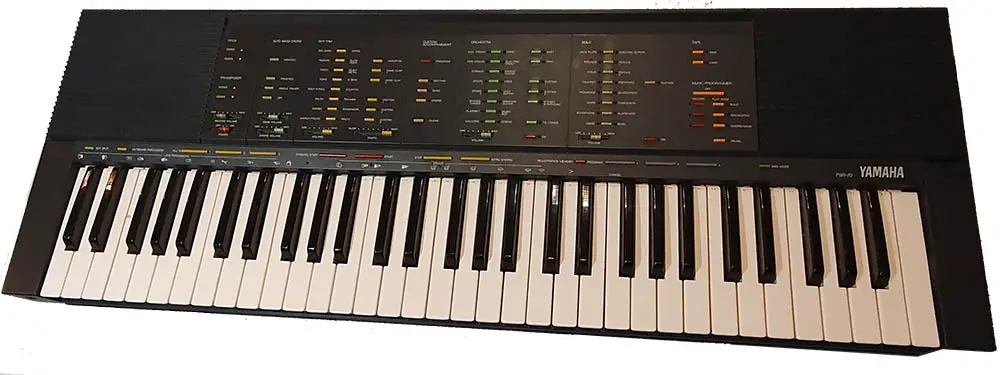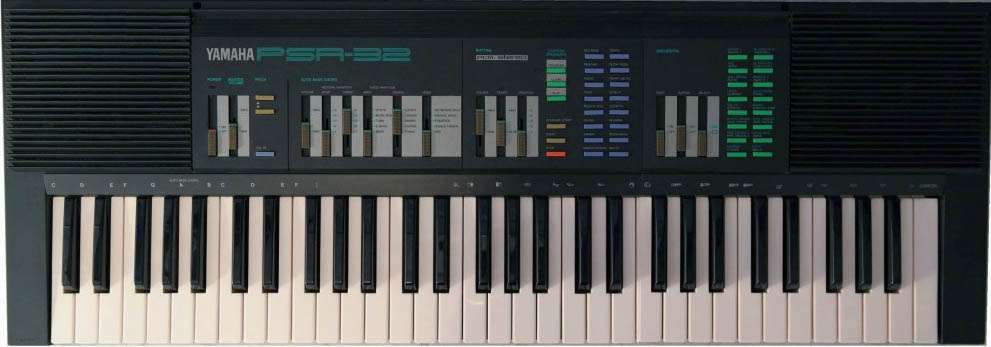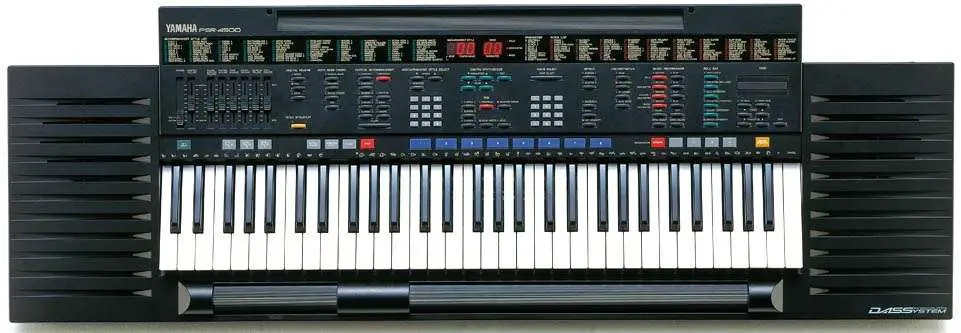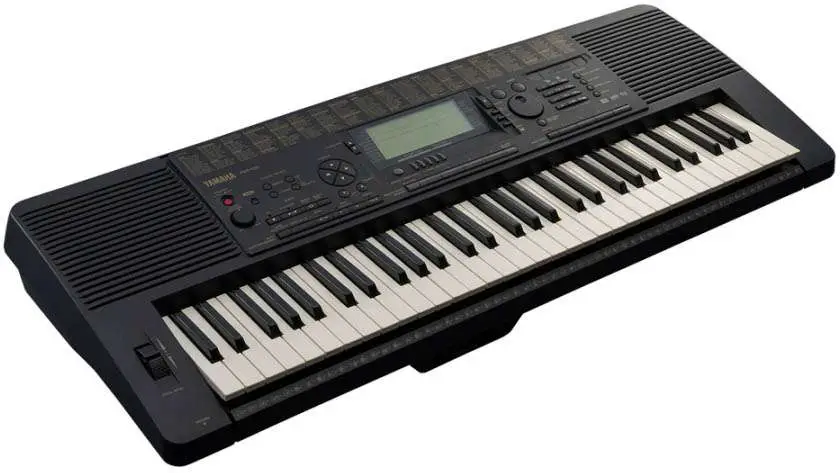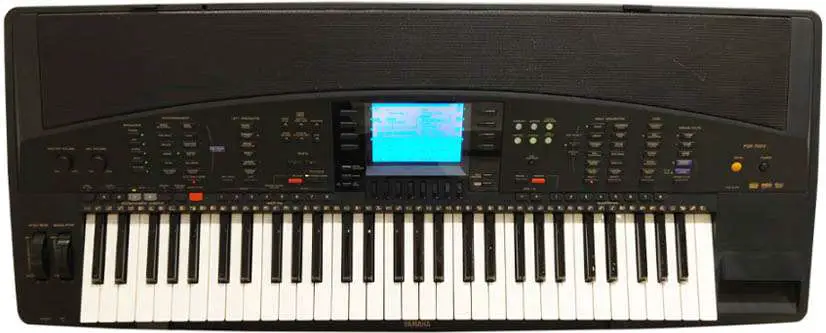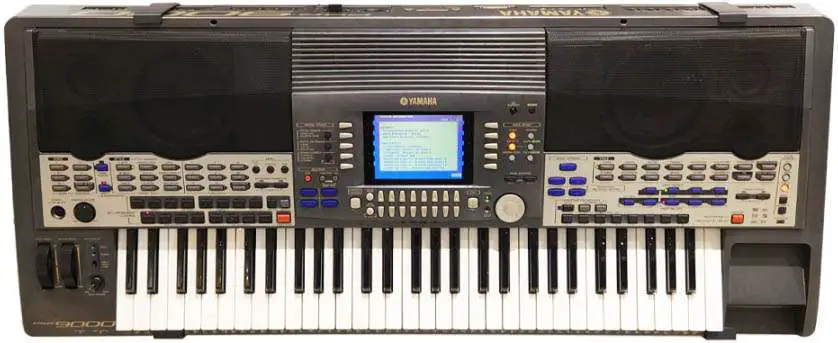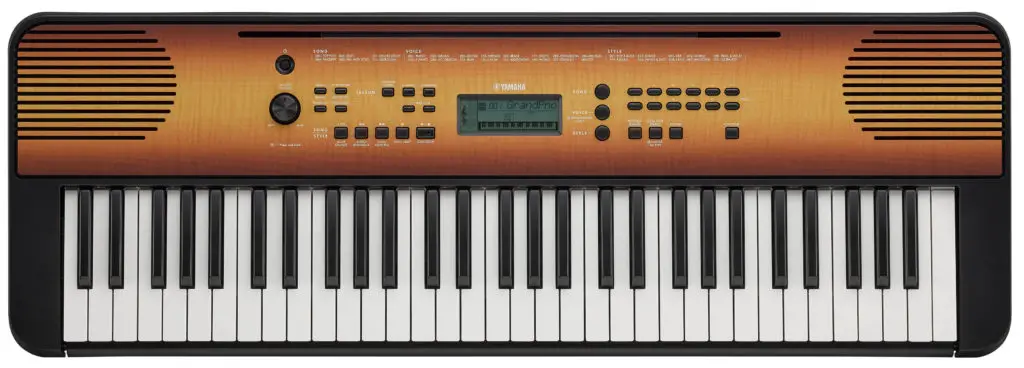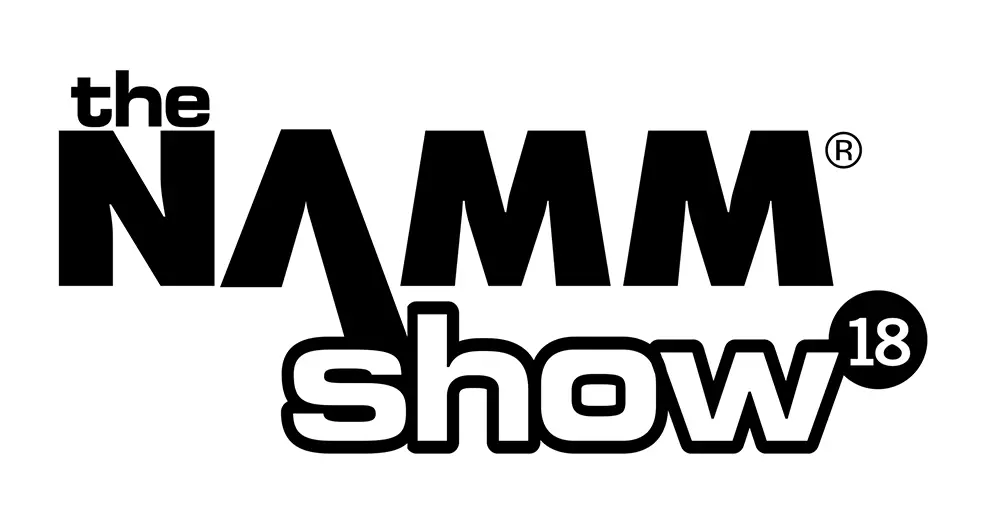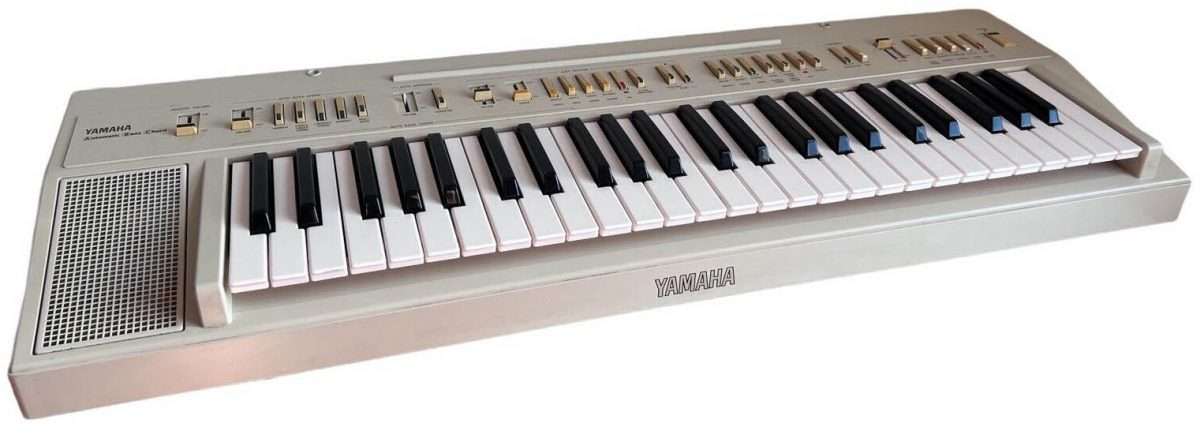For nearly 40 years, Yamaha has created a host of portable musical keyboard instruments under the “PSR” branding. This article sheds light on those models, from 1984 when the first “PortaTone” models emerged, right up to the present day with versatile, high-technology instruments good for both beginners and seasoned keyboard musicians.
There have been close to 175 models with the PSR branding, including very basic keyboards but also those with more high-end features. As technology has improved and prices have dropped, later models have often included more functionality at less expense. Build quality has usually been reasonable at least for amateur home use, and they are usually marketed as being ideal for younger and beginner players.
We’ve tried our best to be as thorough as possible, but with some models now long extinct, and the diminishing availability of accurate information and resources for electronic equipment from the 1980s and 1990s, we can’t automatically cover everything in great detail. We will continue to add to this page as more data becomes available. We’ll also link to other pages, both on this site and elsewhere, when good archive/comparison information and resources are available.
You may also be interested in our feature on Yamaha PortaSound keyboards from the 1980s and ’90s.
First Models
The first model Yamaha released in its PSR range was the PSR-15 in 1984.
Not the lowest numbered PSR created, but the first. While basic by today’s standards, it featured 49 keys (four octaves), six sounds, accompaniments with various finger modes, ability to add an expression pedal, and battery or power adapter usage.
It isn’t clear from the manual which sound generation technology was being used, although we presume some kind of PCM but not Yamaha’s much developed AWM system as this didn’t really come into its own until the 1990s. No MIDI, as this was still a very young technology in the mid ’80s and not really of much value on such a basic keyboard.
Amount of polyphony is unknown but it certainly wasn’t monophonic as it allowed for playing at least one note alongside rhythms and accompaniment sounds. Our guess is perhaps around 8 simultaneous sounds.
MIDI and Buttons
In 1985 Yamaha launched five more PSR models, with control panel interfaces containing more buttons for tone and accompaniment and other function section. MIDI ports also found their way onto the higher end models, including the PSR-50 and PSR-60.
A very rudimentary system for saving program and performance data was introduced on the PSR-60 and PSR-70, by means of connecting a tape recorder to the special “tape” audio jacks and recording data (probably much like home computers of the era did) for subsequent retrieval.
Overall functions were still quite rudimentary but we can already see an increase in number of sounds, polyphony and overall functionality.
The Late ’80s
In 1986 Yamaha launched the two 49-key models PSR-11 and PSR-21, with basic fixed-sensitivity keyboards, plus the PSR-6300 (why the massive jump in numbers perhaps only Yamaha knows) featuring a full five octaves (61 keys) and velocity sensitivity, making it easier to play more expressively without the need to alter panel settings or volume.
The PSR-6300 was a much bigger beast than previous models, with a fold-up control panel and beefy grille-laden speakers left and right.
1987 saw upgrades to the PSR-11 and PSR-21, with the PSR-12 and PSR-22, as has been a hallmark of Yamaha ever since with keyboard instruments in a particular class.
We see a continuation of many colorful buttons in semi-pastel reds, blues and greens for selecting voices, accompaniments and the like. Convincing replication of acoustic instruments, particularly piano, is still patchy on these keyboards, which are still considered very much entry level and did not borrow any of the expensive sound-producing technology from the likes of Yamaha’s Clavinova digital pianos, launched in 1983.
Also launched, the five octave PSR-32, with a range of sliders for variations, and the MIDI-enabled PSR-80 and PSR-90.
In 1988, the PSR-16 (49 keys) and PSR-36 (61 keys) debuted, with similar controls to previously.
Yamaha ramped up production towards the end of the ‘decade of the synth’ with 1989 seeing a whopping eight models being launched including the smaller PSR-6, PSR-7, PSR-27, PSR-37 and PSR-47s plus the PSR-2500, PSR-3500 and PSR-4500, which saw an uptick in the sampling quality, with 12-bit PCM waveforms and 2-operator FM synthesis.
The PSR-4500 had an interesting architecture and design. It had a Dual Architectural Synthesis System (DASS) tone generator which combined FM and AWM tone generators to create realistic sounds, as well as the ability to edit attack, decay and other sound parameters.
By now Yamaha had launched some quite advanced synths and keyboards in its other ranges, such as the SY22, SY35 and TG33, and with technology advancing at a rapid pace and prices inevitably dropping, some of that architecture began making its way into the PSR instruments.
Into the ’90s
The 1990s was probably Yamaha’s most prolific decade for launching PSR models, with well over 70 released from 1990-99. Two things are worth considering here, though. Firstly, many models had only slight variations between them, sometimes as small as cosmetic coloring, or possibly a few sound or style changes, and so were only nominally considered as different models. That said, secondly, it was clear that the PSR series of keyboards was expanding its range from low to mid or even higher-end models, all under the same PSR branding.
At first glance, the number of digits in a product’s model number seemed to indicate a different subclass of instrument, with single digit instruments being fairly basic and/or having a smaller keyboard range, two and three digit instruments being of mid-range, with four-digit PSR models becoming increasingly high end (although as we shall see the whole range became more advanced as the decades progressed).
In the ’90s we saw a progression of low end 49 key instruments, still with modest polyphony, no keyboard sensitivity, and no MIDI. These were almost certainly targeted primarily at children or absolute beginning musicians.
Also released were a number of mid-range 61-key instruments, many of which had touch sensitivity, some with MIDI, which were aimed at those who were very keen to learn on a more expressive keyboard, and possibly even use their PSR keyboard to connect to other instruments or a computer via MIDI. By the ’90s, home computers with built-in or expandable MIDI capability, including the Atari ST and Commodore Amiga, were becoming quite prevalent and affordable, opening up possibilities for home studio musicians at a much more affordable price.
Then, at a slower rate, the higher end PSR models which increasingly borrowed tech from Yamaha’s other higher-end instruments, were being pushed out to those with more cash, ability and ambition.
Lower end models were just starting to eek into double figures for their polyphony, while mid-range models often had 16 notes of polyphony and higher-end keyboards were pushing the high 20s or even 30s.
Just to add to the confusion of the numbering scheme, Yamaha started bringing out PSR models with letters after the numbers—including PC, GM, DJ—or before, such as J. A quick but non-exhaustive look at these suggests that, for example, a PSR-J20 was a keyboard aimed at the Japanese market; GM was for General MIDI (although soon nearly all keyboards would implement this as standard), DJ had various effects and possibly a microphone to simulate basic DJing actions, PC was to provide more obvious PC connectivity options (although, again, this became more common in later years), and so on.
In 1995 the PSR-620 featured a 3½-inch floppy drive and a Music Cartridge slot for allowing performance, voice and other data to be easily stored to standard PC disks or Yamaha’s cartridge format.
The same year, the PSR-7000 was launched primarily as a home keyboard, but gained popularity among professionals for use in performance settings due to its ease of arranging rhythm and bass accompaniments. Proof that the right tool for the job isn’t always the most expensive or ‘pro’ version.
New Century
New model releases slowed down a bit from the year 2000 onwards, and after a flurry from 2000-2004, Yamaha generally released a maximum of three new models per year, most of which were incremental updates on previous models.
It was becoming clear that Yamaha took its PSR line of instruments quite seriously, despite the initial feeling that they weren’t necessarily for ‘serious’ musicians. With the continued development of functionality on Yamaha’s other ranges of digital pianos, synths and music keyboards, and the continued reduction in cost, many features once only found on high end models found their way into even the more modest of PSR models.
Most notable of course is the quality of the sound itself. It probably made little sense for Yamaha to have an inferior, alternative sound system for its cheaper keyboards, meaning that its improving AWM (Advanced Wave Memory) system which could deliver very realistic instrument sounds including piano, was to be found on all of its newer PSR keyboards.
Case in point, take the Yamaha PSR-9000, aimed at professional musicians and with workstation features built in. This would be Yamaha’s last model featuring the Portatone name, with following instruments being the Tyros series.
PSR-E: Entry Level, More Features!
In 2004, Yamaha introduced models labeled as PSR-E. The ‘E’ seemed to suggest these were more entry-level keyboard instruments. That said, what’s considered ‘entry level’ now is far, far advanced and cheaper than what would’ve been considered a beginner instrument back in the 1980s and 1990s.
PSR-S: Advanced Range
The first PSR-S range model appeared in 2006, possibly signalling instruments aimed at more advanced musicians who still wanted something portable and were on a more limited budget. In 2019, the PSR-SX range launched, superseding and building upon that in the PSR-S models. To date, 17 models in the PSR-S and PSR-SX family have been launched, with a number of advanced features including some taken from the then top-of-line Tyros workstations.
By 2010 onwards, with storage space and processing power greatly increased, PSR, PSR-S and PSR-SX models were regularly hitting market with thousands of sounds, accompaniments, up to 128 notes of polyphony, full computer connectivity, and much more.
PSR Models by Model Number
PSR-100
PSR-1000
PSR-11
PSR-110
PSR-1100
PSR-12
PSR-125
PSR-130
PSR-140
PSR-140PC
PSR-150
PSR-15
PSR-16
PSR-160
PSR-170
PSR-1700
PSR-172
PSR-175
PSR-18
PSR-180
PSR-185
PSR-19
PSR-190
PSR-195
PSR-195PC
PSR-2
PSR-200
PSR-2000
PSR-201
PSR-202
PSR-21
PSR-210
PSR-2100
PSR-215
PSR-22
PSR-220
PSR-220PC
PSR-225
PSR-225GM
PSR-225PC
PSR-230
PSR-240
PSR-248
PSR-2500
PSR-260
PSR-262
PSR-27
PSR-270
PSR-2700
PSR-273
PSR-275
PSR-28
PSR-280
PSR-282
PSR-290
PSR-292
PSR-293
PSR-295
PSR-3
PSR-300
PSR-31
PSR-310
PSR-310M
PSR-32
PSR-320
PSR-330
PSR-340
PSR-350
PSR-3500
PSR-36
PSR-37
PSR-38
PSR-40
PSR-400
PSR-4000
PSR-403
PSR-410
PSR-420
PSR-450
PSR-4500
PSR-4600
PSR-47
PSR-48
PSR-50
PSR-500
PSR-500M
PSR-510
PSR-510M
PSR-520
PSR-530
PSR-530PC
PSR-540
PSR-540PC
PSR-550
PSR-5700
PSR-6
PSR-60
PSR-600
PSR-6000
PSR-62
PSR-620
PSR-630
PSR-6300
PSR-640
PSR-6700
PSR-7
PSR-70
PSR-73
PSR-730
PSR-74
PSR-740
PSR-75
PSR-76
PSR-77
PSR-78
PSR-79
PSR-80
PSR-85
PSR-90
PSR-9000
PSR-A2000
PSR-A3
PSR-D1
PSR-E203
PSR-E213
PSR-E223
PSR-E233
PSR-E243
PSR-E253
PSR-E263
PSR-E273
PSR-E303
PSR-E313
PSR-E323
PSR-E333
PSR-E343
PSR-E353
PSR-E363
PSR-E373
PSR-E403
PSR-E413
PSR-E433
PSR-E443
PSR-E453
PSR-E463
PSR-EW400
PSR-EW410
PSR-F51
PSR-GX76
PSR-I425
PSR-I455
PSR-I300
PSR-I500
PSR-J20
PSR-J20C
PSR-J21
PSR-J51
PSR-K1
PSR-S500
PSR-S700
PSR-S900
PSR-S550
PSR-S710
PSR-S910
PSR-S650
PSR-S750
PSR-S950
PSR-S670
PSR-S770
PSR-S970
PSR-S775
PSR-S975
PSR-SX600
PSR-SX700
PSR-SX900
PSRD1DJX
PSR Models by Year
| 1984: | PSR-15 (1) |
| 1985: | PSR-40, PSR-50, PSR-62, PSR-60, PSR-70 (5) |
| 1986: | PSR-11, PSR-21, PSR-6300 (3) |
| 1987: | PSR-12, PSR-22, PSR-32, PSR-80, PSR-90 (5) |
| 1988: | PSR-16, PSR-36 (2) |
| 1989: | PSR-6, PSR-7, PSR-27, PSR-37, PSR-47, PSR-2500, PSR-3500, PSR-4500 (8) |
| 1990: | PSR-2, PSR-18, PSR-28, PSR-38, PSR-48, PSR-19, PSR-4600 (7) |
| 1991: | PSR-3, PSR-31, PSR-73, PSR-100, PSR-200, PSR-300, PSR-400, PSR-500, PSR-500M, PSR-6700 (10) |
| 1992: | PSR-75, PSR-150, PSR-403, PSR-600, PSR-5700 (5) |
| 1993: | PSR-110, PSR-210, PSR-310, PSR-310M, PSR-410, PSR-510, PSR-510M, PSR-1700, PSR-2700 (9) |
| 1994: | PSR-76, PSR-85, PSR-180, PSR-6000 (4) |
| 1995: | PSR-77, PSR-185, PSR-215, PSR-225, PSR-225GM, PSR-225PC, PSR-320, PSR-420, PSR-520, PSR-620, PSR-4000, PSR-A3 (12) |
| 1996: | PSR-78, PSR-190, PSR-220, PSR-220PC, PSR-230 (5) |
| 1997: | PSR-130, PSR-330, PSR-530, PSR-530PC, PSR-630, PSR-730 (6) |
| 1998: | PSR-79, PSR-195, PSR-195PC, PSR-270, PSR-D1, PSR-D1DJX (6) |
| 1999: | PSR-74, PSR-140, PSR-140PC, PSR-240, PSR-248, PSR-340, PSR-540, PSR-540PC, PSR-640, PSR-740, PSR-J20, PSR-J20C (12) |
| 2000: | PSR-160, PSR-201, PSR-260, PSR-262, PSR-282, PSR-550, PSR-9000, PSR-GX76, PSR-J21, PSR-J51 (10) |
| 2001: | PSR-170, PSR-280, PSR-350, PSR-1000, PSR-2000 (5) |
| 2002: | PSR-125, PSR-202, PSR-290, PSR-292, PSR-1100, PSR-2100 (6) |
| 2003: | PSR-172, PSR-273, PSR-275, PSR-450, PSR-K1 (5) |
| 2004: | PSR-175, PSR-293, PSR-295, PSR-E203, PSR-E303 (5) |
| 2006: | PSR-E403, PSR-E213, PSR-E313, PSR-S500 (4) |
| 2007: | PSR-E413, PSR-I425, PSR-S700, PSR-S900 (4) |
| 2008: | PSR-E223, PSR-E323, PSR-S550 (3) |
| 2009: | PSR-S710, PSR-S910 (2) |
| 2010: | PSR-E233, PSR-E333, PSR-S650 (3) |
| 2011: | PSR-E433, PSR-I455 (2) |
| 2012: | PSR-E243, PSR-E343, PSR-S750, PSR-S950 (4) |
| 2013: | PSR-A2000 (1) |
| 2014: | PSR-E253, PSR-E353, PSR-E443 (3) |
| 2015: | PSR-E453, PSR-EW400, PSR-S670, PSR-S770, PSR-S970 (5) |
| 2016: | PSR-E263, PSR-E363, PSR-F51 (3) |
| 2017: | PSR-E463, PSR-EW410 (2) |
| 2018: | PSR-S775, PSR-S975 (2) |
| 2020: | PSR-E273, PSR-E373, PSR-EW310, PSR-I500, PSR-SX600, PSR-SX700, PSR-SX900 (7) |
| 2021: | PSR-E360 (1) |
| 2022: | PSR-E473, PSR-EW425 (2) |
| 2023: | PSR-I300 (1) |

